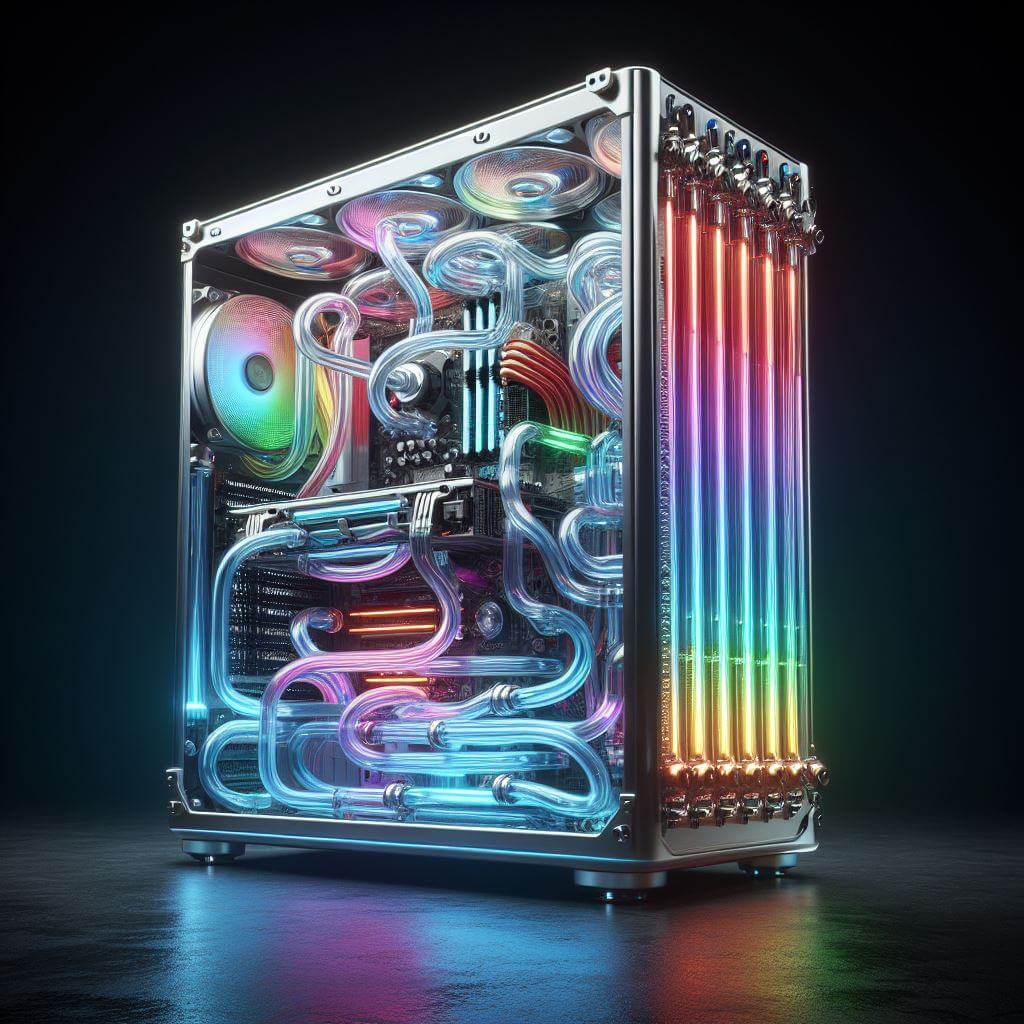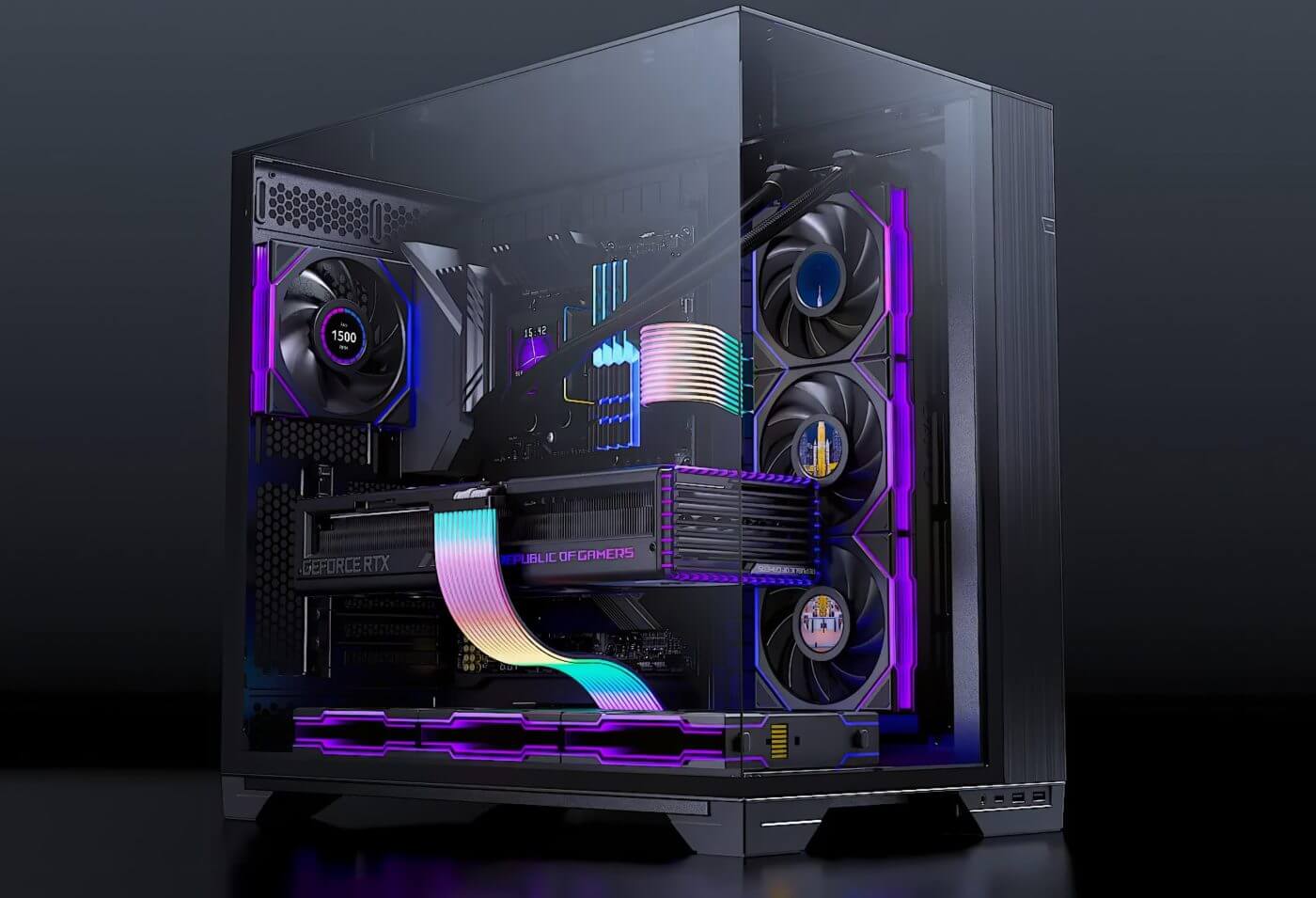Liquid cooling has become a popular choice for PC enthusiasts looking to push the limits of their system’s performance. However, safety concerns often arise when considering this advanced cooling solution. Is liquid cooling safe for your PC? Let’s explore the topic and find out.
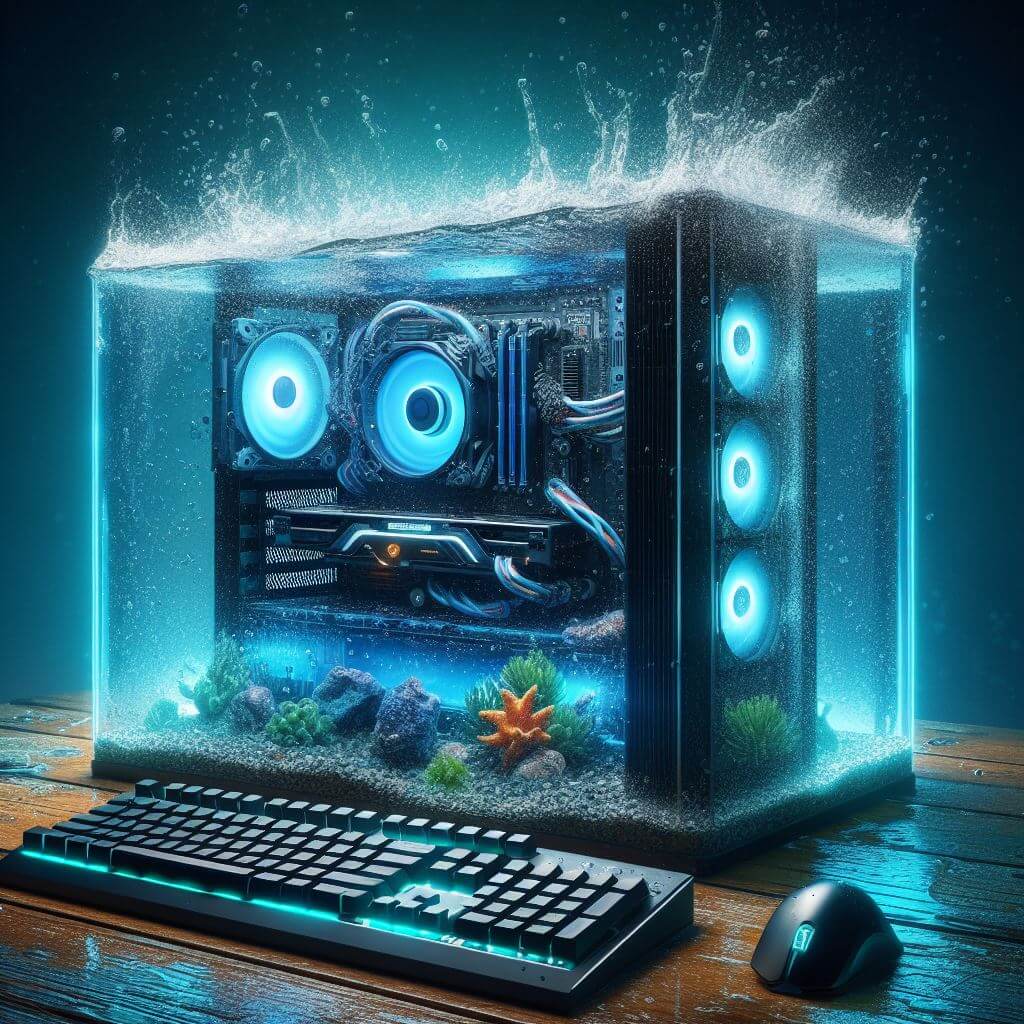
Key Takeaways:
- Liquid cooling can provide improved performance, acoustics and aesthetics for your PC.
- Risks of leaks and potential damage to your setup exist, but with proper installation and maintenance, the chances of experiencing a leak are minimal.
- Consider all-in-one cooling systems as a safer option that reduces the risk of leaks and comes with warranties for peace of mind.
- When deciding between liquid cooling and air cooling, factors such as cost, overclocking needs and personal style preferences should be considered.
- Follow a water cooling safety checklist and specific considerations when installing PC water cooling to ensure optimal safety.
The Risks of Liquid Cooling
When it comes to liquid cooling for your PC, there are some risks to consider. One of the main concerns is the possibility of leaks, which can lead to potential damage to your precious components. However, it’s important to note that with proper installation and maintenance, the chances of experiencing a leaks are minimal.
Despite the minimal risk, it’s crucial to take precautions and thoroughly test your system for leaks. This will help minimize the potential for damage and ensure the longevity of your PC. By being proactive and diligent in your approach, you can enjoy the benefits of liquid cooling without worrying about any potential mishaps.
“With proper installation and maintenance, the chances of experiencing a leak are minimal.”
Regularly inspecting your system, checking for loose fittings and monitoring the performance of your liquid cooling setup are essential practices to prevent leaks. In addition, conducting leak tests before fully powering your components is a crucial step in ensuring the safety of your PC.
To further mitigate the risks associated with liquid cooling, consider using high-quality components and following the manufacturer’s instructions for installation and maintenance. By doing so, you can minimize the likelihood of leaks and potential damage to your PC.
Ultimately, while there are risks involved, liquid cooling can provide significant benefits such as improved heat dissipation and overall performance. By being cautious and mindful of the potential risks, you can enjoy the advantages of liquid cooling without compromising the safety and longevity of your PC.
Liquid Cooling Risks and Precautions
| Risks | Precautions |
|---|---|
| Potential leaks | Thoroughly test for leaks before fully powering the system |
| Component damage | Use high-quality components and follow manufacturer’s instructions |
| Inadequate maintenance | Regularly inspect for loose fittings and monitor system performance |
Tips for Safe Water Cooling
When it comes to water cooling your PC, safety is paramount. By following these essential tips, you can ensure a smooth and secure water cooling experience for your system.
Take Your Time
One of the most important tips for safe water cooling is to take your time during the installation process. Rushing can lead to careless mistakes and potential issues down the line. So, be patient, carefully read through the instructions and take the necessary time to complete each step accurately.
Check Fittings for Tightness
Image:
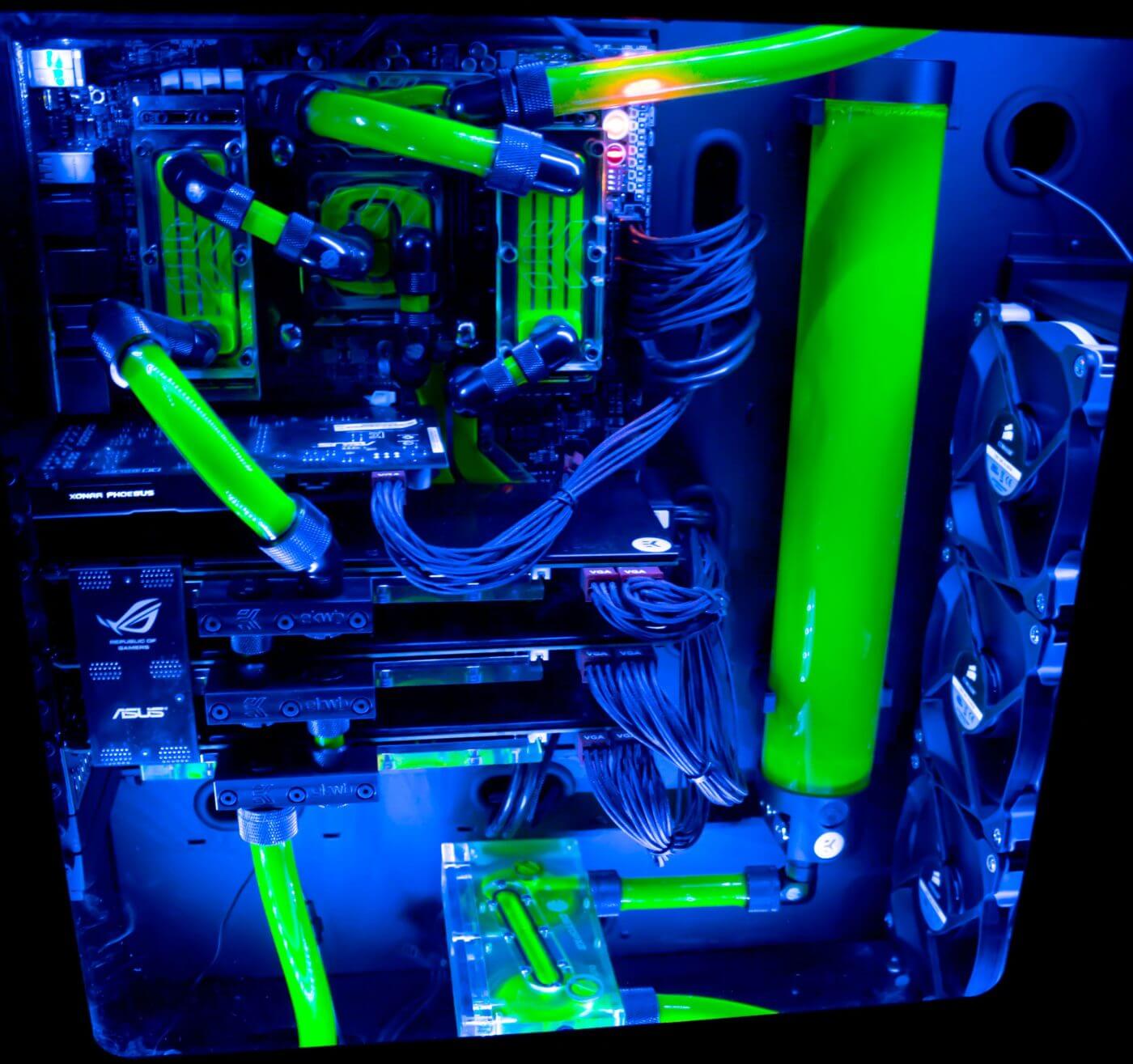
To prevent leaks and ensure the safety of your PC, it’s crucial to check the fittings for tightness. Loose fittings can result in coolant leaks, potentially damaging your components. Before powering up your system, inspect each fitting and ensure it is securely tightened without overtightening, which can lead to stripped threads or damaged O-rings.
Avoid Mounting the Reservoir Directly Above Your Motherboard or Power Supply
When configuring your water cooling setup, it’s best to avoid mounting the reservoir directly above your motherboard or power supply. In the event of a leak, this positioning can lead to severe damage to these critical components. Instead, opt for a location that minimizes the risk of fluid spillage onto sensitive areas.
Perform Leak Testing
Before powering your components, it’s essential to perform leak testing. This involves filling your water cooling system and allowing it to sit for a period, typically 24 hours, while monitoring for any signs of leaks. Leak testing helps identify potential issues and allows you to address them before they cause damage to your PC.
Remember, safety is key when it comes to water cooling your PC. Taking the time to follow these tips can help you avoid potential risks and ensure a safe and efficient water-cooled system.
All-in-One Cooling Systems: A Safer Option
If you’re concerned about the potential risks associated with custom water cooling systems, opting for all-in-one (AIO) cooling systems can provide a safer and more convenient solution for cooling your PC. These pre-bundled components offer the benefits of liquid cooling without the complexity of building a custom loop.
An all-in-one cooling system typically includes a CPU block, radiator, fans and tubing, all pre-assembled and ready for installation. A major advantage of AIO systems is that they come pre-filled and sealed from the factory, greatly reducing the risk of leaks and potential damage to your PC. This makes them an excellent choice for PC enthusiasts who want the performance advantages of liquid cooling without the potential hazards.
An example of a reputable all-in-one cooling system is the EK-AIO Basic 240. Built by EK Water Blocks, a well-known brand in the PC cooling industry, this AIO system offers efficient cooling performance and easy installation. The EK-AIO Basic 240 comes with a 240mm radiator, two 120mm fans and a pump integrated into the CPU block. With its pre-filled design and durable construction, this AIO cooling system provides a reliable and hassle-free cooling solution for your PC.
Benefits of All-in-One Cooling Systems:
- Simplified Installation: AIO systems are designed for ease of use, making them suitable for both novice and experienced PC builders. With pre-assembled components and clear installation instructions, you can enjoy the benefits of liquid cooling without the complexities of a custom setup.
- Reduced Risk of Leaks: AIO systems are factory-sealed, minimizing the chances of leaks and potential damage to your PC. The risk associated with fluid handling and tubing connections is greatly reduced, providing peace of mind.
- Warranty Coverage: Many AIO systems come with warranties, guaranteeing their performance and protecting your investment. This additional level of assurance ensures that you can rely on the cooling system to deliver optimal results.
“Choosing an all-in-one cooling system is a great way to enjoy the benefits of liquid cooling while minimizing the risks associated with custom setups. With their pre-filled design and simplified installation process, AIO systems provide a safer and more convenient solution for liquid cooling your PC.”
| Features | EK-AIO Basic 240 |
|---|---|
| Radiator Size | 240mm |
| Fan Size | 120mm |
| Integrated Pump | Yes |
| Compatibility | Supports major CPU socket types |
Comparing Liquid Cooling and Air Cooling
When deciding between liquid cooling and air cooling for your PC, it’s essential to understand the differences. Both cooling methods have their advantages and considerations, so it’s crucial to choose the option that best meets your needs and preferences.
Liquid cooling offers better heat management and performance compared to air cooling. The use of liquid coolant allows for more efficient heat dissipation, resulting in lower temperatures and improved overall performance for your PC. Liquid cooling systems often feature larger radiators and multiple fans, providing increased cooling capacity.
On the other hand, air cooling is a more common and cost-efficient option. Air coolers are widely available and require less maintenance compared to liquid cooling systems. With air cooling, heat is removed from your PC components through the use of air fans and heatsinks. While it may not offer the same level of performance as liquid cooling, air cooling can still effectively keep your PC within safe temperature ranges, especially for standard usage.
When comparing liquid cooling and air cooling, consider the following factors:
- Cost: Liquid cooling systems tend to be more expensive upfront, requiring additional components such as water blocks, pumps and radiators. Air cooling, on the other hand, is generally more affordable, with air coolers available at various price points.
- Overclocking needs: If you plan to overclock your PC and push your hardware to its limits, liquid cooling is often the preferred choice. Liquid cooling can effectively dissipate the increased heat generated by overclocking, allowing for sustained high-performance operation.
- Size/clearance limitations: Liquid cooling systems require additional space in your PC case for radiators, pumps and reservoirs. Ensure that your case has sufficient clearance and mounting options to accommodate the components of a liquid cooling setup.
- Personal style preferences: Liquid cooling systems offer a visually striking aesthetic with vibrant coolant colors and customizable RGB lighting options. If the visual appeal is important to you, liquid cooling can be a more attractive choice.
Ultimately, the decision between liquid cooling and air cooling depends on your specific requirements and priorities. If you’re seeking top-tier performance, are willing to invest in a more complex cooling setup and prioritize aesthetics, liquid cooling may be the ideal choice. On the other hand, if you’re on a budget, have standard usage requirements and prefer a simpler installation process, air cooling can provide an effective and cost-efficient cooling solution for your PC.
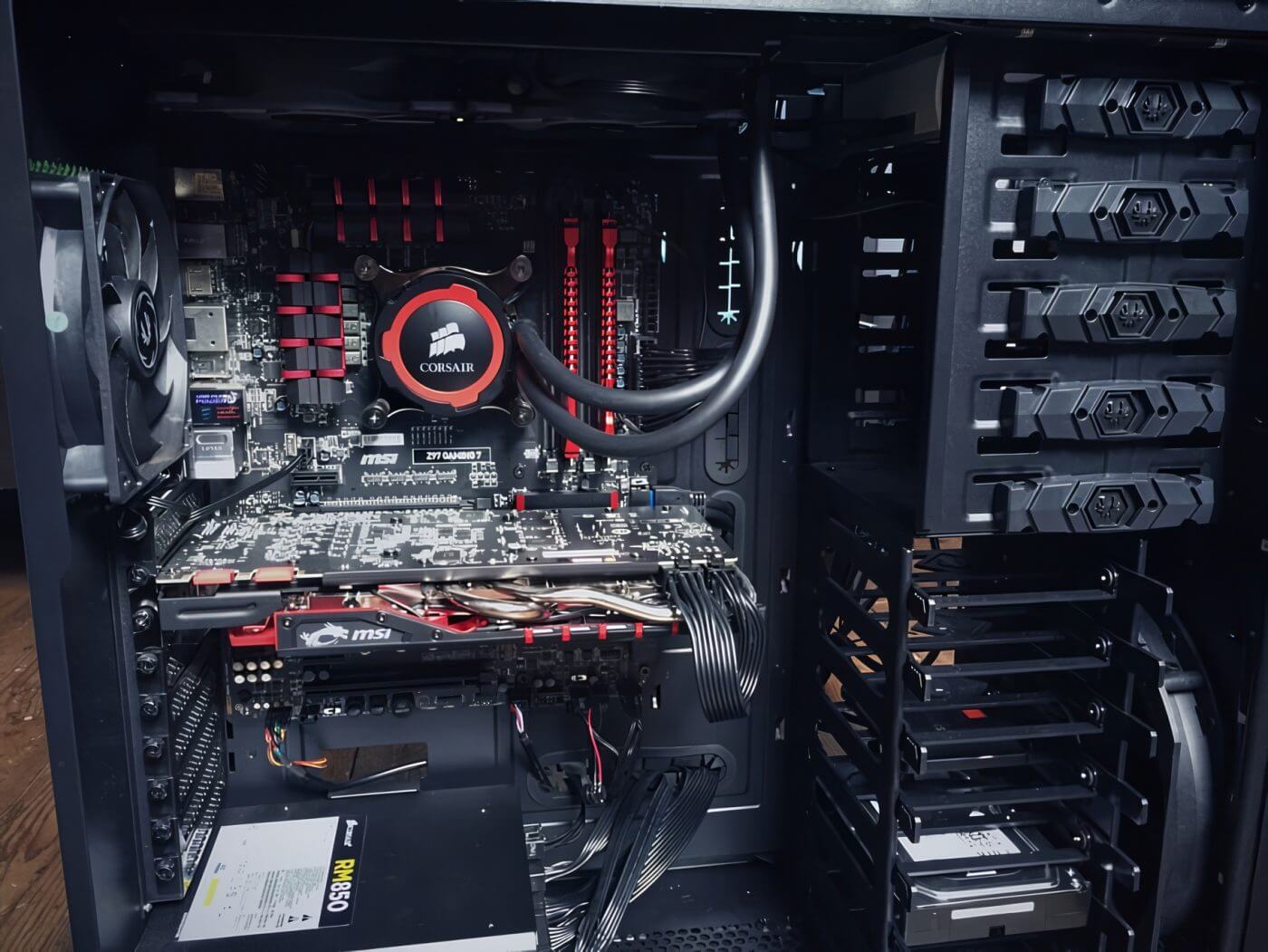
Show a side-by-side comparison of liquid cooling and air cooling for a PC. The liquid cooling system should be represented by a sleek, modern design with blue coolant flowing through transparent tubes. The air cooling system should have bulky fans and heatsinks, with visible dust build-up. The background should be a dark color to really make the components pop.
“The decision between liquid cooling and air cooling depends on your specific requirements and priorities.”
Water Cooling Safety Checklist
To ensure the safety of your water cooling system, follow a safety checklist that covers key aspects. By taking these precautions, you can avoid potential issues and enjoy the benefits of liquid cooling for your PC.
1. Work Clean
Before starting the installation process, make sure your work area is clean and free of dust or debris. This will help prevent any contaminants from entering your water cooling system and causing potential blockages or damage.
2. Check Fittings and Caps for Tightness
When setting up your water cooling system, carefully check all fittings and caps to ensure they are tightly secured. Loose fittings can lead to leaks and damage your PC components, so it’s essential to verify their tightness before powering your system.
3. Use Compatible Tubes
Always use tubes that are compatible with your water cooling components. Using the wrong type of tubing can lead to leaks or even chemical reactions that can damage your system. Refer to the manufacturer’s recommendations for compatible tubing materials.
4. Deburr Tube Ends
If you cut your own tubing, make sure to deburr the ends properly. Sharp edges can damage O-rings or cause leaks. Use a tube cutter and a deburring tool to ensure clean cuts and smooth edges.
5. Clean Radiators Before Installation
Before installing your radiators, flush them with distilled water to remove any particles or contaminants that may have accumulated during manufacturing or storage. This will help maintain optimal performance and prevent blockages in your system.
6. Conduct Leak Tests
Prior to powering your PC, it’s crucial to conduct leak tests to identify any potential leaks in your water cooling system. Fill the loop with distilled water and perform the leak test for at least 24 hours. This will give you peace of mind and allow you to address any issues before powering your components.
7. Use Distilled Water or Distilled Water-Based Coolants
When filling your water cooling system, use distilled water or distilled water-based coolants. Tap water or other types of coolant can contain minerals or additives that can lead to corrosion or blockages in your system over time.
8. Avoid Food-Based Dyes
While adding dyes to your coolant can enhance the aesthetics of your water cooling system, it’s important to avoid food-based dyes. These dyes can promote bacterial growth or cause clogs in your loop. Instead, opt for specially formulated dyes that are safe for PC water cooling.
9. Make Regular Inspections and Maintenance
Regularly inspect your water cooling system for any signs of leaks, corrosion, or deterioration. Check fittings, tubes and coolant levels. It’s also recommended to flush and refill your system periodically to maintain optimal performance and prevent any potential issues.
Water Cooling Safety Checklist
| Checklist Item | Description |
|---|---|
| Work Clean | Ensure a clean work area to prevent contaminants from entering the system. |
| Check Fittings and Caps for Tightness | Verify that all fittings and caps are tightly secured to avoid leaks. |
| Use Compatible Tubes | Only use tubes that are compatible with your water cooling components. |
| Deburr Tube Ends | Remove sharp edges from cut tubing to prevent damage or leaks. |
| Clean Radiators Before Installation | Flush radiators with distilled water to remove contaminants. |
| Conduct Leak Tests | Perform leak tests before powering the system to identify and fix any leaks. |
| Use Distilled Water or Distilled Water-Based Coolants | Use distilled water or distilled water-based coolants for filling the system. |
| Avoid Food-Based Dyes | Avoid using food-based dyes that can cause clogs or bacterial growth. |
| Make Regular Inspections and Maintenance | Regularly inspect and maintain the water cooling system for optimal performance. |
Considerations When Installing PC Water Cooling
When it comes to installing PC water cooling, safety should be your top priority. By following these essential considerations, you can ensure a smooth and secure installation process.
1. Filling the System with Caution
When filling your water cooling system for the first time, it’s important to exercise caution. Take your time and follow the manufacturer’s instructions to avoid any spills or accidents. Remember, a properly filled system is essential for optimal cooling performance.
2. Ensuring Properly Tightened Fittings
Properly tightened fittings are crucial in preventing leaks and maintaining the integrity of your water cooling system. Carefully check each fitting to ensure it is securely tightened, but be cautious not to overtighten and damage the components.
3. Checking for Leaks in Rotatable Adapters
Rotatable adapters are commonly used in water cooling setups to provide flexibility in routing the tubing. It is essential to thoroughly check these adapters for any potential leaks before powering your system. Performing a leak test can help identify any issues early on.
4. Testing Water Blocks and Panels for Cracks
Prior to installation, inspect your water blocks and panels for any cracks or damage. Even the smallest crack can lead to leaks and compromise the safety of your system. If any damage is found, it is recommended to replace the affected component before proceeding.
5. Using Properly Sized Tubes
Choosing the right tube size is essential for proper water flow in your cooling system. Ensure that the tubes you use are compatible with your fittings and properly sized to minimize any resistance or blockages. This will help maintain optimal performance and prevent overheating.
6. Installing a Drain Valve for Easy Maintenance
Installing a drain valve in your water cooling system can greatly simplify maintenance tasks. It allows you to easily remove coolant when needed, making cleaning and future upgrades more convenient. Consider adding a drain valve to your setup for added convenience and ease of use.
7. Monitoring Temperatures and Flow
Regularly monitoring temperatures and flow rates in your water cooling system is essential for detecting any potential issues. Sudden temperature increases or decreased flow could indicate a blockage, pump failure, or other problems that require immediate attention. Use temperature sensors and flow meters to keep a close eye on your system’s performance.
By considering these important factors when installing PC water cooling, you can ensure a safe and efficient setup. Taking the necessary precautions will help you enjoy the benefits of liquid cooling while minimizing the risks associated with improper installation.
| Considerations | Description |
|---|---|
| Filling the System with Caution | Ensure a careful and proper filling process to avoid spills and optimize cooling performance. |
| Ensuring Properly Tightened Fittings | Check and tighten fittings securely to prevent leaks and maintain system integrity. |
| Checking for Leaks in Rotatable Adapters | Thoroughly inspect rotatable adapters for leaks before powering the system to avoid potential issues. |
| Testing Water Blocks and Panels for Cracks | Inspect water blocks and panels for cracks or damage to prevent leaks and maintain system safety. |
| Using Properly Sized Tubes | Choose tubes that are compatible and properly sized to ensure optimal water flow and prevent blockages. |
| Installing a Drain Valve for Easy Maintenance | Add a drain valve to facilitate system maintenance and coolant removal for cleaning or upgrades. |
| Monitoring Temperatures and Flow | Regularly monitor temperatures and flow rates to detect any abnormalities or potential issues. |
Managing Temperatures and Flow in Water Cooling
Properly managing temperatures and flow in your water cooling system is crucial for optimizing the performance and safety of your PC. When the temperatures and flow are well-maintained, you can ensure that your components are operating within their recommended limits and avoid any potential issues such as overheating or system failure.
Clogged water blocks can significantly impact the flow of coolant through your system, leading to decreased performance and increased temperatures. To prevent this, regular maintenance and monitoring are essential. It’s recommended to clean your water blocks periodically to remove any debris or build-up that may hinder the flow. This can be done by carefully disassembling the blocks and cleaning the fins and channels with a soft brush or compressed air.
Another important factor to consider when managing temperatures in your water cooling system is the water temperature itself. It’s recommended to keep the water temperature between 30°C and 45°C to ensure optimal performance and prevent any potential damage to your PC components. Monitoring the water temperature regularly using temperature sensors can help you keep it within the desired range.
Additionally, it’s crucial to avoid overfilling the expansion tank of your water cooling system. Leaving some room for expansion allows for any increase in volume due to temperature changes, preventing any potential leaks or pressure build-up. Keep the tank filled to about 90% capacity to accommodate this expansion.
A well-designed drain system can also help in managing the flow and temperature of your water cooling system. By incorporating a drain valve at a convenient location in your loop, you can easily remove old coolant for maintenance and cleaning. This ensures that the flow remains consistent and helps in preventing any potential blockages or overheating.
Overall, managing temperatures and flow in your water cooling system requires regular maintenance, monitoring and attention to detail. By following these guidelines, you can optimize the performance and lifespan of your PC components, ensuring a reliable and efficient cooling solution.
Conclusion
In conclusion, liquid cooling can be a safe option for your PC when installed and maintained correctly. While there are risks associated with leaks and potential damage, following proper safety measures can significantly minimize these risks. By using all-in-one (AIO) cooling systems, regularly inspecting your setup and conducting leak tests, you can ensure the safety of your PC.
When deciding between liquid cooling and air cooling, consider factors such as cost, overclocking needs and personal style preferences. Liquid cooling offers better heat management and performance, while air cooling is a more common and cost-efficient option.
Remember, liquid cooling is not without its risks, but with the right precautions, you can enjoy improved performance, acoustics and aesthetics for your PC. Prioritize safety and regularly maintain your liquid cooling system to ensure a safe and efficient PC experience.
Key Takeaways:
- Liquid cooling can be safe when installed and maintained correctly.
- Following safety measures and conducting regular inspections can minimize the risk of leaks and damage.
- All-in-one (AIO) cooling systems provide a safer option for liquid cooling.
- Consider factors such as cost, overclocking needs and personal style preferences when choosing between liquid cooling and air cooling.
Remember, PC safety should always be a top priority when considering liquid cooling options for your setup.
Related Articles
Continue your exploration of PC cooling with these informative articles. Whether you’re interested in liquid cooling, air cooling, or optimizing your PC’s cooling system, these articles cover a range of topics to help you make informed decisions and enhance your PC’s performance and safety.
The Benefits and Drawbacks of Liquid Cooling
Discover the advantages and disadvantages of liquid cooling for your PC. Learn how liquid cooling can provide superior heat management and performance, but also the potential risks and maintenance involved. Make an informed decision about whether liquid cooling is the right choice for your PC.
The Top Cooling Systems for PCs
Explore the best cooling systems available for your PC. This article showcases a selection of high-quality liquid and air cooling solutions from reputable brands, enabling you to choose the system that best suits your needs, budget and PC specifications.
A Comparison: Liquid Cooling vs. Air Cooling
Understand the differences between liquid cooling and air cooling to determine which option is ideal for your PC. Compare factors such as heat dissipation, noise levels, maintenance requirements and cost-effectiveness. This comprehensive comparison helps you make an informed choice for your PC cooling needs.
Temperature Control and Your PC’s Cooling System
Learn how to effectively manage temperature control with your PC’s cooling system. Discover tips and techniques for monitoring and regulating temperatures to ensure optimal performance and prevent potential damage. Maintain a cool and stable environment for your PC components.
Overclocking and Cooling: Maximizing Performance
Gain insights into overclocking and its impact on your PC’s cooling requirements. Understand the relationship between increased performance and the need for efficient cooling. Discover how to strike the right balance to unleash the full potential of your PC without compromising its safety and longevity.
Optimizing Your PC’s Cooling System
Take steps to optimize your PC’s cooling system for peak performance and reliability. This article provides valuable tips, tricks, and best practices for enhancing airflow, choosing suitable cooling components and maintaining an efficient cooling setup.
Comparison of Liquid Cooling and Air Cooling
| Liquid Cooling | Air Cooling | |
|---|---|---|
| Heat Management | Efficient heat dissipation | Adequate heat dissipation |
| Noise Levels | Generally quieter | Potential for louder fans |
| Maintenance | Regular checks for leaks and component upkeep | Cleaning dust buildup on fans and heatsinks |
| Cost | Higher upfront investment | Lower upfront cost |
Continue your reading journey to expand your knowledge and make informed decisions for your PC cooling needs. Dive deeper into the world of PC cooling and unlock the potential for enhanced performance and longevity.
Shop Cooling Systems
If you’re ready to shop for cooling systems for your PC, you’ll find a wide range of options available to suit your needs. Whether you’re interested in liquid cooling or air cooling, there are reputable brands offering high-quality products and components.
When selecting a cooling system, it’s important to consider your PC’s specific requirements for optimal cooling performance and safety. Different cooling systems offer varying levels of efficiency, noise levels and aesthetics, so choose one that aligns with your preferences.
If you’re looking for maximum cooling performance and are willing to invest in a custom setup, liquid cooling systems can provide superior heat dissipation and often allow for better overclocking potential. On the other hand, air cooling solutions are more affordable and easier to install, making them a popular choice for many PC enthusiasts.
Make sure to conduct thorough research, read reviews and compare different products before making your purchase. By choosing the right cooling system for your PC, you can ensure that your components stay at optimal temperatures, prolonging their lifespan and improving overall performance.
FAQ
Is liquid cooling safe for my PC?
When installed and maintained correctly, liquid cooling can be safe for your PC. However, there are risks of leaks and potential damage, so it’s important to follow safety measures and conduct regular inspections.
What are the risks of liquid cooling?
The main risk of liquid cooling is the possibility of leaks, which can potentially damage your PC components. However, with proper installation and maintenance, the chances of experiencing a leak are minimal.
What tips can you provide for safe water cooling?
To ensure safe water cooling, take your time during installation, check fittings for tightness, avoid overtightening and conduct thorough leak tests before powering your components. Other tips include not mounting your reservoir directly above your motherboard or power supply.
Are all-in-one cooling systems a safer option?
Yes, all-in-one (AIO) cooling systems provide a safer and easier-to-install solution for liquid cooling your PC. These pre-bundled components come pre-filled and sealed from the factory, reducing the risk of leaks and offering warranties for peace of mind.
What is the difference between liquid cooling and air cooling?
Liquid cooling offers better heat management and performance compared to air cooling. However, air cooling is a more common and cost-efficient option that requires less maintenance. Consider factors such as cost, overclocking needs and personal style preferences when deciding between the two.
What should I include in a water cooling safety checklist?
To ensure water cooling safety, remember to work clean, check fittings and caps for tightness, use compatible tubes, deburr tube ends, clean radiators before installation, conduct leak tests, use distilled water or distilled water-based coolants, avoid food-based dyes and make regular inspections and maintenance.
What should I consider when installing PC water cooling?
When installing PC water cooling, consider filling the system for the first time with caution, ensuring fittings are properly tightened, checking for leaks in rotatable adapters, testing water blocks and panels for cracks, using properly sized tubes and installing a drain valve for easy maintenance. Monitoring temperatures and flow is also important.
How do I manage temperatures and flow in water cooling?
To properly manage temperatures and flow in your water cooling system, perform regular maintenance, monitor for clogged water blocks, keep water temperature between 30°C and 45°C, avoid filling the expansion tank to the top and use temperature sensors and a drain system to prevent potential problems.
Is liquid cooling a safe option for my PC?
When installed and maintained correctly, liquid cooling can be safe for your PC. However, it’s important to be aware of the risks, follow safety measures and conduct regular inspections to ensure the safety and optimal performance of your system.
Where can I find more information about PC cooling?
Explore our related articles section for more information about PC cooling. You can find articles on the benefits and drawbacks of liquid cooling, the best cooling systems for PCs and comparisons between liquid cooling and air cooling.
Where can I shop for cooling systems for my PC?
If you’re ready to shop for cooling systems for your PC, check out a variety of options available. Whether you’re interested in liquid cooling or air cooling, there are various products and components to choose from to suit your needs. Select reputable brands and consider your PC’s specific requirements for optimal cooling performance and safety.

